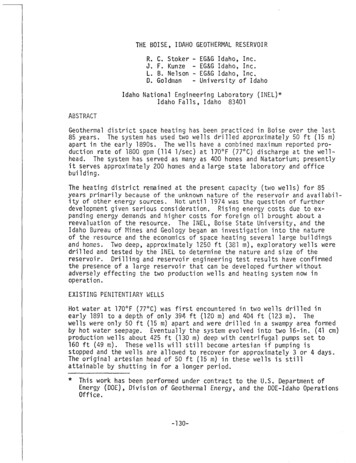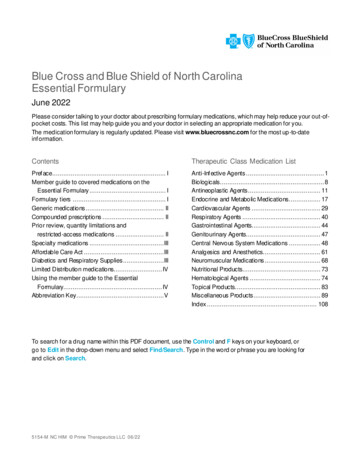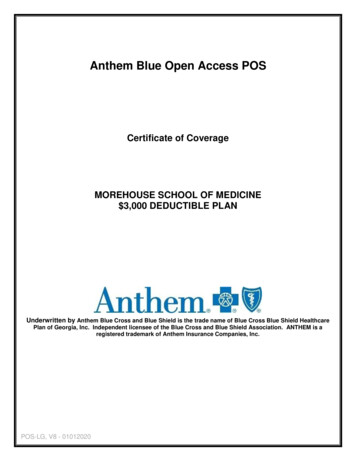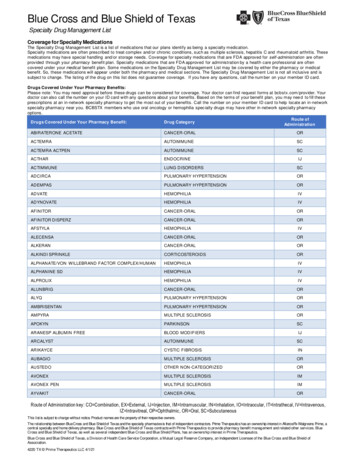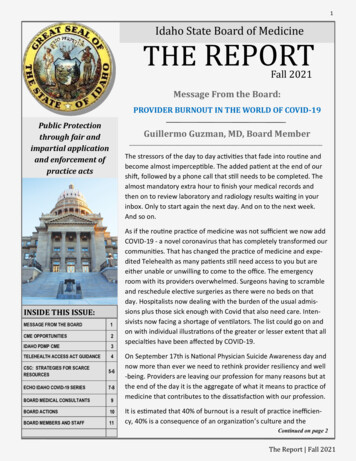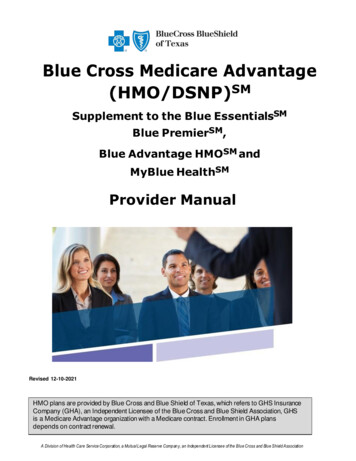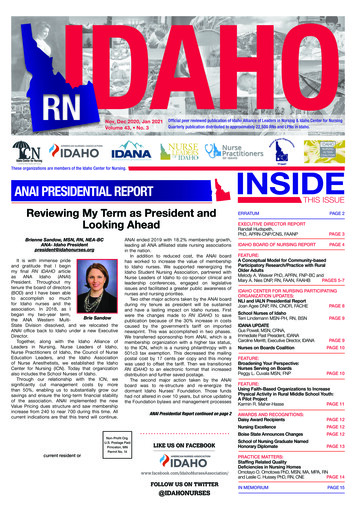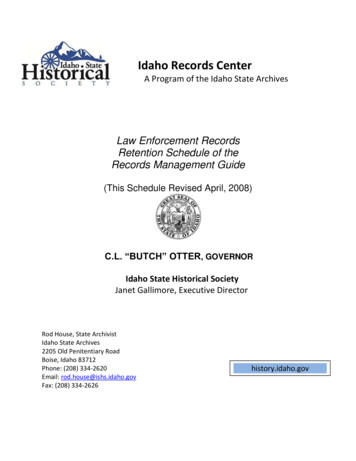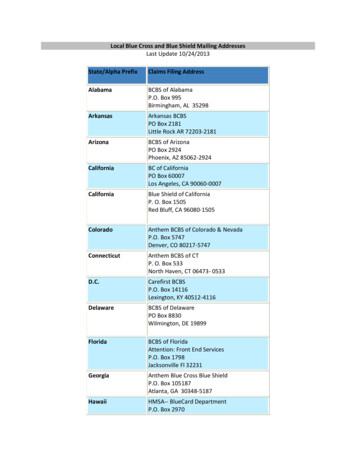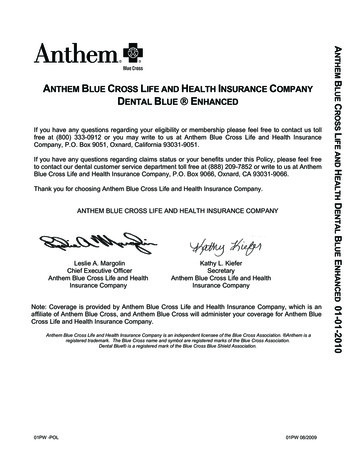
Transcription
Blue Cross of Idaho Health Service, Inc.Part III - Actuarial MemorandumIndividual Qualified Health PlansEffective January 1, 2019I, Erik R. Wheeler, am a Manager of Actuarial Services for Blue Cross of Idaho Health Service, Inc. (BCI), HIOS Issuer ID#61589. I am a member in good standing of the American Academy of Actuaries. The purpose of this memorandum isto describe the development of Idaho rates for Blue Cross of Idaho’s Individual Market Qualified Health Plans to beeffective January 1, 2019 and to support an opinion whether the rates:(a) are actuarially sound as required by Idaho Code 41-5206(4)(b);(b) comply with the premium requirements set forth in Idaho Department of Insurance Bulletin 2013-02 andcorresponding updates; and(c) comply with the Individual Market Reform provisions of the Affordable Care Act.The following memorandum also contains information required by Idaho Department of Insurance Bulletin 2011-07 andHHS Actuarial Memorandum and Certification Instructions, and describes the calculation of the numbers used in theUnified Rate Review Template. This memorandum is intended for the use of the regulators in the Idaho Department ofInsurance, the United States Department of Health and Human Services, and their contractors. It is not intended for anyother purpose.4.1 Redacted Actuarial MemorandumThis is not a redacted memorandum.4.2 General Information SectionCompany Legal Name:State:HIOS Issuer ID:Market:Effective Date:Blue Cross of Idaho Health Service, Inc.Idaho61589Individual01/01/2019Primary Contact Name:Primary Contact Telephone Number:Primary Contact Email Address:Erik R. Wheeler(208) 810-2785erik.wheeler@bcidaho.comSecondary Contact Name:Brian SlabeSecondary Contact Telephone Number: (208) 472-5791Secondary Contact Email Address:brian.slabe@bcidaho.comActuarial MemorandumQHP Individual RatesEffective 1/1/2019Page 1July 20, 2018
4.3 Proposed Rate Increase(s)The rate increases for this product apply to Individual products that are part of the individual single risk pool, as definedby 45 CFR § 156.80. The rate increases will only apply to the qualified health plans (QHP) from the single risk pool.Reason for Rate Increase(s): Medical Inflation: (Cost per instance of type of service) increase due to contract and fee schedule changes. Increased Utilization: The usage of services is expected to be different in the projection period than in theexperience period. Benefits have been changed in the products offered in effective period due. Changes have been made to allowproducts to meet metallic tier requirements of the ACA. Other changes have been made to meet expectedmarket demands and state regulatory requirements. Changes in Taxes and Fees. Anticipated changes in state and federal laws and regulations.For 2019, there are 72 renewing plans introduced as new to the market in 2017 and 2018, as well as 9 plans beingterminated. Benefit changes and cost sharing changes exist on the renewing plans to maintain regulatory complianceand will vary by plan. The rate changes in this filing do not affect rate changes for grandfathered or the transitionalproducts that are part of the individual single risk pool in the experience period. Rates for QHP products reflect impactsof grandfathered and transitional products that migrate into QHP products.Table 1 summarizes the effect of the rate increases.Table 1Anticipated Effect of the Rate ChangeAverage Rate All PlansCurrent RateProjected RateIncrease 503.72 555.7910.3%4.4 Market Experience4.4.1 Experience Period Premium and ClaimsThis information is based on the single risk pool in the experience period.Actuarial MemorandumQHP Individual RatesEffective 1/1/2019Page 2July 20, 2018
Experience Period: 01/01/2017 to 12/31/2017Date through which payments have been made on claims incurred during experience period: 3/31/2018Premiums (net of MLR Rebate) in Experience Period: 178,386,541The experience period used for both the rate development and the URRT was Calendar Year 2017, with claims paidthrough 3/31/2018. IBNR comprises less than 1% of total incurred claims, hence block-specific IBNR factors were notdeveloped. IBNR factors were developed by the month a claim is incurred and the items our regression analyses havefound most significant is the lag between incurral date and payment date, which includes coordination with Medicare,UB vs. non-UB billing form, and whether the claim was billed directly to Blue Cross of Idaho or was billed to another BlueCross Blue Shield Association company and routed to Blue Cross through the Interplan Transfer System (ITS).Completion factors are assigned claim-by-claim based on these characteristics and applied uniformly to allowed charges,paid amounts, and utilization counts. Prescription Drug claims complete quickly and with three months runout the IBNRwas negligible.The rates were developed using Non-Grandfathered experience.Premium was based on total revenues, including any expected accounting adjustments used in the Blue Cross of Idahoannual financial statements. Revenues include payments made to Blue Cross of Idaho for advance premium creditsassociated with 2017 QHP products.The expected MLR rebate rules and templates for 2017 are available. The MLR rebate was estimated for the IndividualSingle Risk Pool as of December 31, 2017 for Blue Cross of Idaho annual financial statements. The expected rebate of 0.00 was used in the annual financial statements and is consistent with current expectations.Allowed and Incurred Claims Incurred During the Experience Period:Allowed and incurred claims are captured in BCI claims payment system. Pharmacy claims are captured through thePharmacy Benefit Manager (PBM) systems. Pharmacy rebates are those received by BCI for the Individual single riskpool. Value Based contract payments are claim liabilities set in accordance with risk based contracts BCI has executedwith various provider entities.The Index Rate is defined by the instructions as the EHB portion of projected allowed claims divided by all single risk poollives. The Index Rate for the experience period was based on claim experience from 1/1/2017 through 12/31/2017 forall non-Grandfathered Blue Cross of Idaho business subject to Idaho Code 41-5206. 100% credibility was given to thisexperience. This follows the single risk pool definition of the instructions.Completion factors are used to develop the Medical incurred but not reported (IBNR), based on BCI’s CommercialMedical and Pharmacy block of business, split by type of claim, whether Medicare was primary or not for coordinationof benefit claims, and by whether the claims were submitted directly to BCI or routed through the Blue Cross Blue ShieldAssociation Interplan Transfer System (ITS). The same completion factors were applied to paid claims on a claim-byclaim basis for both incurred and allowed claims. Using the larger block of business reduces probability of actual IBNRvarying from expected. All BCI commercial claims paid by BCI’s Prescription Benefit Manager were used to set the IBNRfor Drug. The factors developed were applied claim-by-claim to the experience period claims.Actuarial MemorandumQHP Individual RatesEffective 1/1/2019Page 3July 20, 2018
Capitation Cost Calculation:Blue Cross of Idaho pays capitation charges for vaccinations. The state of Idaho has a childhood immunization programin which the state purchases vaccines at a low cost and provides vaccines to physicians for administration to the insured,including employees of self-funded employers, Medicaid, and uninsured populations. Insurers and groups are assessedbased on the number of persons under age 19.Table 2 shows the experience period incurred claims. Table 3 shows the period allowed claims.Table 2Experience Period Incurred ClaimsCalendar Year 2017ItemAmountProjected PMPM Non-Capitated Claims 321.00Table 3Experience Period Allowed ClaimsCalendar Year 2017ItemAmountPMPM Claims 446.41None of the policies cover Non-Essential Health Benefits.4.4.2 Benefit CategoriesBenefit Categories in Worksheet 1, Section II are calculated by Blue Cross of Idaho using a claim grouper developed byMilliman to count and classify medical claims by service category. The grouper classifies claims into many categorieswhich were mapped to the categories described in the instructions for the URRT. Idaho’s Vaccine for Children program,described in Section 4.4.1, has been treated as a capitated service. Pharmacy claims submitted through our PBM areclassified as Prescription Drug claims. The same completion factors were applied on a claim-by-claim basis to theutilization measures as the allowed and paid amounts.The utilization used for capitation payments was the number of member-months for persons under age 19.Conceptually, this corresponds to how BCI is charged for participation in the program.Table 4 shows allowed claims split by type of service.Actuarial MemorandumQHP Individual RatesEffective 1/1/2019Page 4July 20, 2018
Table 4Experience Period Allowed ClaimsCalendar Year 2017ServiceUtilizationDescriptionInpatient HospitalAdmitsOutpatient HospitalUtilization ,041.92109.28109.66Other MedicalServices698.33349.0520.31CapitationBenefit Period12,000.002.792.79Prescription DrugPrescriptions9,522.5598.7778.38Total 446.414.4.3 Projection FactorsChanges in the Morbidity of the Population Insured:The morbidity in the 2019 projected population is expected to be differ from the experience period population. Reasonsfor the difference include: The impact of transitional membership existing in the experience period pool.2018 enrollees that are new to BCI coverage.Anticipated changes in state and federal laws and regulations.The composite anticipated change in morbidity between the experience period and projection period is provided inTable 5.Table 5Morbidity of the Population InsuredItemAmountRisk QHP to Total Single Risk PoolActuarial MemorandumQHP Individual RatesEffective 1/1/20191.2999Page 5July 20, 2018
Other Adjustments:Changes in Benefits:Table 6 shows the adjustment for benefit differences. The average benefit relativity (weighted by member months) iscompared in the experience period and the projection period.Anticipated changes in benefits between the experience period and the projection period are: Anticipated changes in state and federal laws and regulations. Changes in cost sharing for the 2019 plan designs The impact of the Idaho state specific reinsurance pool.Table 6Expected Benefit ChangeBenefit LevelExpected Average (MemberWeighted) Factors(a)(b)Projected age Factors fromExperience Period0.4901Factor Differential1.1250Changes in Demographics:The age and gender mix in the BCI first quarter enrolled 2018 QHP population is expected to be representative of theprojected period mix. It has been assumed, based upon analysis by cohort, that the individuals leaving the QHP risk poolwill have a similar age distribution as those remaining in the pool. The age distribution was compared to the experienceperiod for the entire single risk pool using the Idaho-approved QHP age rate factors. The change in age category wasfurther adjusted for risk differences by comparing the experience period risk factors to experience period age factors.This is to capture average cost differences not already captured by age rating curve.Table 7 shows the composite impact of the “Other” category components.Actuarial MemorandumQHP Individual RatesEffective 1/1/2019Page 6July 20, 2018
Table 7Other AdjustmentsItemAmount0.9906Total Other Adjustment FactorTrend Factors (cost/utilization):Trend factors were based on observed QHP Individual year over year trends since 2014 and current BCI pricing trends forcommercial business. The QHPs include several products that feature lower-cost networks that first became availableduring the experience period. The adjustments in contractual payment rates are reflected in the cost trend inaccordance with the Unified Rate Review Template instructions.For the purpose of Worksheet 1 of the Unified Rate Review Template, all claims paid by the Prescription BenefitManager were classified as Pharmacy. Medical claims were classified using Milliman’s Health Cost Guidelines (HCG)claim classification software.Table 8 shows the breakdown of trend between cost and utilization. These trends apply to non-capitated claim costsonly.Table 8Allowed TrendItemMedicalDrugCost Factor1.0271.042Utilization Factor1.0251.042Table 9 summarizes the projection factors used in worksheet 1 of the URRT.Table 9Projection Period AdjustmentsItemPop'l risk MorbidityOtherCostUtilInpatient Hospital1.3000.9911.0271.025Outpatient 1.0271.025Other 001.000Prescription Drug1.3000.9911.0421.042Actuarial MemorandumQHP Individual RatesEffective 1/1/2019Page 7July 20, 2018
Population Risk and Morbidity factors: For non-capitated claim costs, this is the product of the morbidity increaserounded to three decimals. The morbidity increase represents the change in the cost for the population eligible forcoverage, and the selection increase represents the additional selection compared to the experience period due to theenacted and anticipated market rules. Capitation for vaccines for children under 19 was assumed to be unaffected. QHPbenefit design required coverage of pediatric vision for those under 19 as an Essential Health Benefit. To provide thisbenefit, BCI contracted with VSP for those under 19.Other Factors: The accumulation of the anticipated demographic profile changes, the impact of covered benefitchanges, and the net result of the Idaho state specific reinsurance program.Cost Trend Factors: Includes underlying medical and prescription drug trend and changes in contracting rates withexisting providers.Utilization Trend Factors: This is based on Blue Cross of Idaho’s Idaho medical and prescription drug coverage.No projection factors have been applied to capitation payments as the PMPM rate is assumed to remain flat betweenthe experience and projection periods given the changes in demographics. The factors have been set to 1.000.4.4.4 Credibility Manual Rate DevelopmentThe characteristics of the Individual QHP market are significantly different than other commercial populations. Manualrates were not used.4.4.5 Credibility of ExperienceBCI’s Individual QHP pool had 352,892 member months for 2017 and BCI’s Single Risk Pool in 2017 had 445,406 membermonths. Using a standard of 10,000 members (120,000 member months), both of these populations are considered tobe fully credible.4.4.6 Paid to Allowed RatioAverage benefit relativity for the projection period is contained within Table 6.4.4.7 Risk Adjustment and ReinsuranceThe Risk Adjustment program is anticipated to result in a 1% payable by Blue Cross of Idaho in 2019, in addition to theRisk Adjustment User Fee. This is based on a preliminary analysis of the 2017 payment provided by the IdahoDepartment of Insurance, the addition of the high claimant adjustment, and emerging 2018 enrollment. The netexpected risk adjustment income includes user fees.The Temporary Reinsurance Program ended in benefit year 2017, and neither taxes nor recoveries are anticipated forbenefit year 2019.Exchange fees are based on the percentage fee charged times the expected utilization of the exchange by members.Table 10 shows the Net risk adjustment, Net Expected Federal TRP recoveries and the exchange fee.Actuarial MemorandumQHP Individual RatesEffective 1/1/2019Page 8July 20, 2018
Table 10Risk Adjustment and TRP RecoveriesCalendar Year 2018ItemAmountNet Expected Risk Adjustment Income( 5.70)Net Expected TRP Recoveries 0.00Idaho-Specific Reinsurance 0.73Exchange Fees 10.684.4.8 Non-Benefit Expenses and Profit & RiskAdministrative Expense Load:Overhead expenses are allocated across all departments on a monthly basis and posted to the general ledger.Depending on the type of expense, a statistical driver is chosen to determine the share of the expense account allocatedto each department (cost center). The statistical drivers used are square footage, salary dollars and FTE counts.Further allocation of expenses for line of business costing is based on the determination of the allocation of netproductive hours for each department. Where possible, that allocation is determined by identifying how time is actuallyspent through the use of time-studies and/or inputs from management. In the case that those metrics do not provide afull allocation of resources, a secondary statistic is employed to allocate the remainder of the department. Statisticsinclude claims counts, claims dollars, members, contracts and call volume. The statistic used is the one that best alignswith the activities within the department being allocated. The resulting data is stored in an enterprise performancemanagement system.Table 11 shows the administrative expense load.Table 11Administrative FeesItemAmount%Administrative Expense Load 53.389.5%Profit (or Contribution to Surplus) & Risk Margin:The anticipated pre-tax margin included in the premium is 2.00%. Premium is generally received in advance of coveragebeing provided, ensuring that the cash flow is positive. Investment income would therefore be positive, and is ignoredin the analysis. Blue Cross is a mutual insurance company and does not maintain a cost of capital model, as the sourceof capital is the cumulative margin provided by its insurance and administrative operations.Actuarial MemorandumQHP Individual RatesEffective 1/1/2019Page 9July 20, 2018
The Health Insurer Provider Fee (HIP Fee) is not deductible for Federal Income Tax purposes. Therefore, additionalpremium needs to be collected to pay the Federal Income Tax on the portion of premium collected to cover the HealthInsurer Fee. This amount will show as underwriting gain on BCI’s financial statements. BCI’s marginal tax rate is 21%. Itis also financially appropriate for an insurance company to provide for an underwriting gain in the premium. Expectedprofit shown in table 12 does not include HIP Fee. The expected federal income tax includes tax on expected profit aswell as the tax on HIF.Table 12 shows the anticipated profit and federal income tax components of the premium rates.Table 12Risk Contingency and Profit CalculationItemPMPM AmountProfit @2% of Premium 11.24Expected Federal Income Tax 3.65Taxes and Fees:Market place user fees are included in taxes and fees as summarized in Table 13.Table 13 includes the components of the Tax and Fee component of the premium. Risk Adjustment Charges andExchange fees have been classified as adjustments to claim costs, as required in the instructions. Federal Income Taxesare reported as a tax, also required by the instructions.Table 13Taxes and FeesItemAmountTotal Taxes & Fees 27.84The estimated Health Insurer Fee percent for 2019 (to be paid in 2020) is calculated as the percent fee for 2016 (paid in2017) as calculated by the IRS, multiplied by the statutory total collections in 2019 (based on 2018 premiums) divided bythose in 2016 (based on 2015 premiums). This fee has been offset in the premium calculation by the anticipated savingsfrom the HIT fee collections for the Individual QHP market from the suspension of the fee in 2019 payment year (basedon 2018 premium).Table 14 shows the projected loss ratio.Actuarial MemorandumQHP Individual RatesEffective 1/1/2019Page 10July 20, 2018
Table 14Projected Loss RatioItemAmountMedical Loss Ratio87.4%4.6 Application of Market Reform Rating Rules4.6.1 Single Risk PoolThe individual single risk pool is established according to the requirements in 45 CFR § 156.80(d). The data includes allnon-grandfathered individual plans including transitional plans.4.6.2 Index RateBCI has no benefits in excess of the Essential Health Benefits (EHB). The index rate is the total allowed cost shown inTable 3. The Index Rate is to be developed following the specifications of 45 CFR § 156.80(d)(1). The Index Rate is basedon the total combined claim costs for providing the EHBs for the single risk pool. The Index Rate is derived by dividingthe total combined EHB allowed claims for the single risk pool by all covered lives in the single risk pool.Table 15Projection Period Index RateCalendar Year 2019ItemAmountProjection Period Index Rate 642.344.6.2.1 Small Group Quarterly Rate Filings:Not applicable to the individual single risk pool4.6.3 Market Adjusted Index RateThe Market Adjusted Index Rate is the Projection Period Index Rate adjusted for expected net Risk Adjustmentrecoveries or payments and increased for expected exchange fees. Table 16 shows the calculation of the MarketAdjusted Index Rate.Actuarial MemorandumQHP Individual RatesEffective 1/1/2019Page 11July 20, 2018
Table 16Market Adjusted Index RateItemAmountMarket Adjusted Index Rate 660.884.6.4 Plan Adjusted Index RatesPlan adjusted index rates are calculated by applying factors to the Market Adjusted Index rates. Factors: Expected utilization of services Network costs specific to a plan Benefit relativity factors Catastrophic pooling factor Tobacco load factor. The change in rates was calculated by applying the tobacco rating load to expectedmembership with tobacco use. The base rates are then reduced to offset the additional revenue from thesmoker load. Loading factor for administrative costsDetail of calculations are discussed in section “4.7.2 AV Pricing Values”Table 17 (in Appendix 1) displays the Plan adjusted Index Rates both before and after adjusting for tobacco use. Therates reflect the factors above.Table 17a (in Appendix 1) displays the Plan adjusted Index Rates both before and after adjusting for tobacco use for thescenario that CSR subsidization payments are funded. The rates reflect the factors above.Table 18 shows the loading factor adjustments.Table 18Loading Factor CalculationItemAmountAdjustment Factor1.164534.6.5 CalibrationThe Calibrated Plan Adjusted Index Rate is intended to approximate the premium at the average age for a Non-Smokerwith a Geographic Loading factor of 1.0000. This is compliance with 45 C.F.R. §147.102. The Plan Adjusted Index Ratesin Table 17 are market-wide, represent the average age, gender, geographic, and smoker mix of the projection period,and are not calibrated. The instructions require the calibration to be performed in two separate steps, one step for agedemographics and another for geographic region.Actuarial MemorandumQHP Individual RatesEffective 1/1/2019Page 12July 20, 2018
Table 19Calibrated Plan Adjusted Index RatesAvg. Monthly ProjectedEnrollmentPlan Adjusted Index Rate42,342 562.19Geographic FactorAgeCurveTobaccoFactor1.00521.61691.0196Age 21,RegionLoad1.0000Rate 339.26The rounded average age of the projected enrolled population is expected to be 48 years old.4.6.6 Consumer Adjusted Premium Rate DevelopmentThe consumer adjusted Premium rates are developed starting with the Plan Adjusted Index Rates in Table 17.Adjustment was made for Age and Geographic factors.4.7 Plan Product Info4.7.1 AV Metal ValuesThe AV calculator could not model Blue Cross’s 2019 prescription drug benefits correctly. All plan designs include a 7tier pharmacy benefit design. The AV calculator does not differentiate cost share inputs with this benefit type. The AVwas calculated using the AVC for the benefit in each of the plan design’s custom drug tiers. The AVC-calculated AVswere weighted based on appropriate statistics derived from group data. Script counts or allowed amounts were usedfor weighting depending whether the benefit was modeled with a copay or coinsurance.For each plan that was calculated using this alternate methodology, a separate certification is provided.Per the instructions, the “AV Pricing Value represents the cumulative effect of adjustments made by the issuer to movefrom the Market Adjusted Index Rate to the Plan Adjusted Index Rate”. The AV Pricing Value was calculated as the PlanAdjusted Index Rate from Table 17, divided by the Market Adjusted Index Rate, calculated in Table 16.4.7.2 AV Pricing ValuesBenefit Design Value Calculation MethodologyThe model for evaluating benefit design was based on our consultant’s health cost guidelines. Frequency and chargefactors for this table are generally calibrated for a large employer population. Utilization factors, average charge perservice numbers, and claim probability distributions were trended to the 1/1/2019 effective date, adjusted to Idahospecific levels, and charge per service factors. Claim probability distributions were reduced to reflect BCI’s negotiateddiscounts. The utilization factors in these models are for the large group market and therefore reflect changes inbehavior driven by benefit design only. These models do not reflect the impact of member selection.Actuarial MemorandumQHP Individual RatesEffective 1/1/2019Page 13July 20, 2018
Table 6 summarizes the values of the QHP benefit plans derived from these models. Each benefit plan was evaluatedand two statistics were calculated.(1) The pricing value relative to a 100% benefit plan using a PPO network, assuming the expected utilization that a100% benefit plan would induce. This is referred to as the Benefit/Network/Utilization Factor.(2) The percentage of allowed charges that are expected to be paid under the plan, where both the allowed chargesand the paid amount are calculated using the plan design’s expected utilization. This number is referred to asthe Benefit-Only Factor or the Pricing AV.Two other statistics are used as part of the pricing calculation. The Network Factor is the relativity of the allowed claimcost between the standard PPO fee schedule and lower-cost network plans. The Benefit / Network / Utilization factorhas both the utilization and network factors as intrinsic portions of its derivation. A metal level adjustment factor wasapplied for non-catastrophic plans. This factor applies the allowed metal level differentials published by the IdahoDepartment of Insurance.Catastrophic Pool AdjustmentThe ACA creates a separate risk adjustment pool for young adults under age 30 and persons who can demonstratehardship. The term “young adult” has not been precisely defined. In 2012, BCI estimated that the catastrophic pool’scost would be 12% lower than the non-catastrophic pool. The 2012 factor is not expected to differ significantly fromcurrent. The 2012 factor is used for consistency. This calculation assumed that the definition is persons age 21 through29. Those under 21 have an age factor of .635 and would not require rate relief through a separate risk adjustmentpool.To calculate the relative cost of the two risk pools, the expected cost of each pool was calculated based on the followingassumptions: No persons eligible for a subsidy would qualify for the catastrophic plan through hardship.10% of those not eligible for a subsidy would qualify for the catastrophic plan through a hardship exemption.All persons over 300% of the poverty level who are ages 21 through 29 select a catastrophic plan.The age distribution assumed was based on BCI’s individual business during 2012.The cost profile of all members was modeled based on their age and gender according to our consultant’s standard age /gender cost distribution. The risk of the entire individual market and the risk in the catastrophic pools were modeledusing these assumptions. The ratio of projected cost to allowed age / gender factors was 12% higher for the noncatastrophic population than for the catastrophic population.4.7.3 Membership Projections2019 Membership Projections were developed based upon BCI’s Individual QHP enrollment distribution for the monthof April 2018.Actuarial MemorandumQHP Individual RatesEffective 1/1/2019Page 14July 20, 2018
Projected 2019 BCI EnrollmentProjected ilver187,978Gold35,593Total508,0994.7.4 Terminated Plans and ProductsBlue Cross of Idaho’s intent is to maintain all Grandfathered and Transitional (“Grandmothered”) products at leastthrough 2019. In 2017, Blue Cross of Idaho replaced its broad-network products with narrow network products, addedproducts that better meet the market requirements, and eliminated low-membership products. BCI is terminating 9existing ACA compliant plans as a result of a network consolidation for 2019. All remaining plans are renewing for 2019.4.7.5 Plan TypePre-QHP (Transitional) Benefit ProductsThis rate filing does not apply to any products in existence during 2013. The products are summarized in thismemorandum because their experience forms the basis of the rates for BCI’s 2019 Individual Market Qualified HealthPlans.All products are Affordable Care Act (ACA) compliant. Effective with the January 2012 renewals, essential healthbenefits are not subject to global annual nor lifetime dollar limits (August 2012 renewals for Farm Bureau products).There are seven benefit families in Blue Cross of Idaho’s non-grandfathered, non-group, transitional portfolio. Allproducts except certain HSA options cover prescription drugs.BlueCare PPO: The amount of benefit payment depends upon whether the services are in-network [provided by apreferred provider organization (PPO) contracting provider] or out-of-network [provided by a non-contracting provider]Simply Blue: These are products with no benefits for chiropractic services, growth hormone therapy, allergy injections,allergy testing, mental health or substance abuse servicesHSA Blue: These are High Deductible Health Plans that can provide coverage over tax-favored Health Savings Accounts.The amount of benefit payment depends upon whether the services are in-network [provided by a preferred providerorganization (PPO) contracting provider] or out-of-network [provided by a non-contracting
Unified Rate Review Template. This memorandum is intended for the use of the regulators in the Idaho Department of Insurance, the United States Department of Health and Human Services, and their contractors. It is not intended for any other purpose. 4.1 Redacted Actuarial Memorandum This is not a redacted memorandum. 4.2 General Information Section

